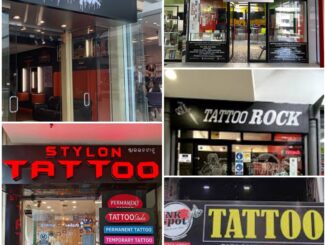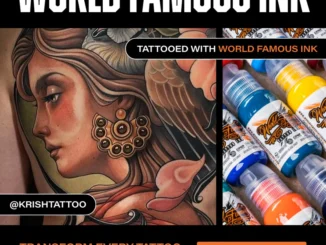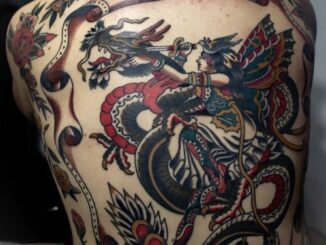
By Daniel Silva
Tattoos have long been a canvas of personal expression, a means of narrating one’s story, beliefs, or affiliations through indelible ink. Despite their growing acceptance in contemporary society, tattoos are still surrounded by a variety of stereotypes—both positive and negative. Understanding these stereotypes can provide insight into how tattoos are perceived and how these perceptions shape individuals’ interactions and self-identities.
The Evolution of Tattoo Culture
To appreciate the modern stereotypes surrounding tattoos, it is important to first understand their historical context. Tattoos have been present in human societies for thousands of years. Early examples include the ancient Egyptians, who used tattoos for ritualistic and symbolic purposes, and Polynesian cultures, where tattoos were integral to social identity and status. In many of these societies, tattoos held sacred significance and were markers of strength, courage, and social hierarchy.
However, the perception of tattoos began to shift with the spread of Western colonialism and the rise of the Victorian era. Tattoos became associated with criminals and outcasts, especially in the context of the penal colonies and military institutions. The stigma associated with tattoos persisted into the 20th century, where they were often linked with rebellious subcultures and marginalized groups.
In recent decades, there has been a notable shift in tattoo culture, with tattoos moving from the fringes of society into mainstream acceptance. This transition has led to the emergence of new stereotypes—both positive and negative—that reflect changing societal attitudes and values.
Positive Stereotypes
1. Artistic Expression
One of the most prominent positive stereotypes associated with tattoos is their role as a form of artistic expression. In today’s world, tattoos are often viewed as a legitimate and respected art form. Many people admire the skill and creativity required to design and ink a tattoo, recognizing it as a personal and artistic endeavor.
Tattoos are celebrated for their aesthetic qualities and the unique way they allow individuals to showcase their personal style and creativity. This positive stereotype is bolstered by the rise of tattoo artists who are recognized as skilled craftsmen and artists, often featuring their work in galleries and exhibitions.
2. Individuality and Personal Empowerment
Tattoos are frequently associated with individuality and personal empowerment. For many, getting a tattoo represents a deliberate choice to assert one’s identity and control over their body. This positive stereotype highlights tattoos as symbols of personal autonomy and self-expression.
In a society that increasingly values personal narrative and self-definition, tattoos serve as a way for individuals to assert their uniqueness. This has contributed to the perception of tattoos as empowering symbols that reflect a person’s journey, beliefs, and values.
3. Cultural and Historical Significance
Tattoos are also recognized for their cultural and historical significance. Many tattoos are deeply rooted in cultural traditions and historical practices. For instance, tribal tattoos in various indigenous cultures often carry profound meanings related to lineage, achievements, and spiritual beliefs.
This positive stereotype acknowledges the role of tattoos in preserving and honoring cultural heritage. Tattoos are seen as a way to connect with and maintain traditions, providing a link between past and present.
4. Professionalism and Success
Contrary to past perceptions, tattoos are increasingly seen as compatible with professionalism and success. In fields where individuality and creativity are valued, such as the arts, entertainment, and fashion, tattoos are often viewed as a sign of success and confidence.
The growing acceptance of tattoos in corporate settings also reflects this positive stereotype. As workplace cultures become more relaxed and inclusive, many professionals proudly display their tattoos, which are increasingly seen as a non-issue in hiring and career advancement.
Negative Stereotypes
1. Criminality and Deviance
One of the most enduring negative stereotypes associated with tattoos is their link to criminality and deviance. Historically, tattoos were often used to mark prisoners, criminals, and marginalized individuals. This association with criminal behavior has perpetuated the stereotype that tattoos are indicative of a troubled past or deviant behavior.
Despite significant changes in tattoo culture, this stereotype persists in some circles. People with visible tattoos might still face judgments or assumptions about their character, particularly in conservative or traditional settings.
2. Rebellion and Anti-Social Behavior
Tattoos are often linked with rebellion and anti-social behavior. This stereotype originates from the association of tattoos with punk and alternative subcultures, which were seen as counter-cultural and defiant. The perception that tattoos are a form of rebellion or a statement against societal norms continues to influence how tattoos are viewed.
Individuals with tattoos may sometimes be unfairly labeled as troublemakers or non-conformists, particularly if their tattoos are large, unconventional, or provocative.
3. Lack of Professionalism
Another negative stereotype is that tattoos signify a lack of professionalism. Despite the growing acceptance of tattoos in various professional fields, some people still perceive tattoos as unprofessional or inappropriate in formal settings. This stereotype is particularly strong in industries with traditional dress codes and conservative values.
People with tattoos might face discrimination or biases in the workplace, as some employers and clients may still hold negative views about tattoos. This can impact hiring decisions and career progression, particularly in more traditional fields.
4. Lack of Seriousness
Tattoos are sometimes associated with a lack of seriousness or maturity. The stereotype suggests that people with tattoos are impulsive or lack the foresight to understand the long-term implications of their choices. This view can be particularly strong among those who see tattoos as transient trends rather than meaningful personal statements.
Impact of Stereotypes on Tattooed Individuals
The stereotypes associated with tattoos—both positive and negative—can significantly impact the lives of those who choose to adorn their bodies with ink. These impacts can manifest in various ways, including social interactions, professional opportunities, and self-perception.
Social Interactions
Tattoos can affect how individuals are perceived and treated in social settings. Positive stereotypes might lead to admiration and respect, particularly if the tattoos are seen as artistic or culturally significant. Conversely, negative stereotypes can result in prejudice and exclusion, with tattooed individuals facing unwarranted judgments and discrimination.
Professional Opportunities
In the professional realm, tattoos can influence hiring decisions and career advancement. While some industries and workplaces have become more accepting, others maintain conservative views that can disadvantage tattooed individuals. This can limit opportunities for those with tattoos, particularly in traditional fields.
Self-Perception
Tattoos can also impact how individuals perceive themselves. Positive stereotypes may reinforce a sense of pride and empowerment, while negative stereotypes can lead to feelings of self-doubt or insecurity. The perception of tattoos as a form of rebellion or unprofessionalism can affect how individuals view their own choices and identity.
Navigating Tattoo Stereotypes
For those who choose to get tattoos, navigating the associated stereotypes involves understanding and addressing both the positive and negative perceptions that come with their decision. Here are some strategies for managing tattoo-related stereotypes:
Educating Others
One effective way to address negative stereotypes is through education. By sharing the personal significance and artistic value of their tattoos, individuals can challenge misconceptions and foster a greater understanding of the diverse meanings behind tattoos.
Choosing the Right Setting
In professional environments where tattoos might be viewed negatively, individuals can make strategic choices about tattoo visibility. Opting for tattoos in less visible areas or choosing designs that align with professional norms can help mitigate potential biases.
Embracing Positive Aspects
Focusing on the positive aspects of tattoos—such as their role in artistic expression and personal empowerment—can help individuals embrace their choices with confidence. Celebrating the cultural and historical significance of tattoos can also contribute to a more nuanced understanding of their value.
Advocating for Inclusivity
Advocating for greater inclusivity and acceptance in professional and social settings can help shift perceptions and reduce stigma. By promoting a more open and diverse view of tattoos, individuals and communities can work towards breaking down stereotypes and fostering a more accepting society.
Conclusion
Tattoos have evolved from their historical associations with criminality and rebellion to become a respected form of artistic and personal expression. The stereotypes associated with tattoos—both positive and negative—reflect broader societal attitudes and values. Understanding these stereotypes provides valuable insight into how tattoos are perceived and the impact they have on individuals.
As society continues to evolve, so too will the perceptions of tattoos. By challenging negative stereotypes and embracing the positive aspects of tattoo culture, individuals can navigate the complex landscape of tattoo-related stereotypes and contribute to a more inclusive and accepting world.



Be the first to comment